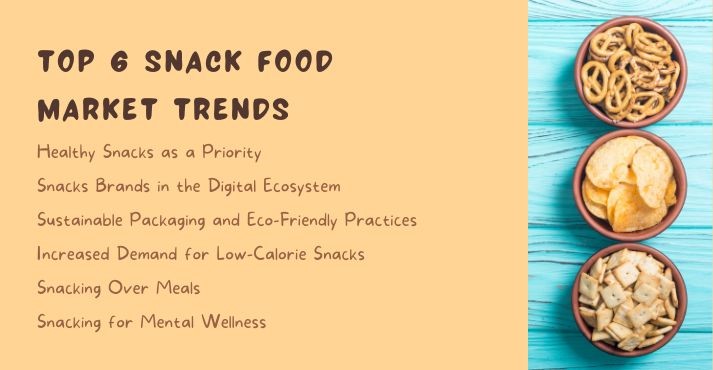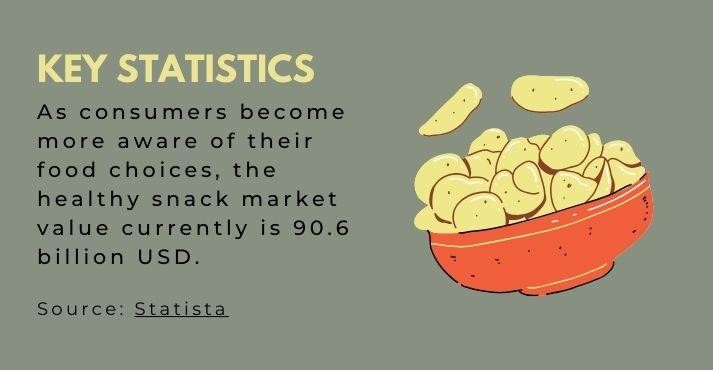Snacking has become more than just a passing indulgence.
Evolving into a way of life, trends in the snack industry are redefining the landscape like never before. As snacking consumers search for new products, flavors, and packaging, snack companies must stay ahead of these trends in the snack food industry.
Snack sales have stayed strong even as prices have increased, and consumers continue to purchase snacks, but the places and ways are changing with both affordability and cravings considered.
Top 6 Snack Food Market Trends

The sector is poised for development in the coming years. Revenue in the snack food market amounts to US$251.10bn in 2024, with an expected growth rate of 6.33% (CAGR 2024-2029).
The snack market share is divided into cookies & crackers, potato chips, tortilla chips, flips, and pretzels. The market is anticipated to experience shifts with these dynamic snacks market trends.
Let’s explore each.
1. Healthy Snacks as a Priority
Health-conscious consumers are seeking snacks to satisfy and satiate their cravings. There’s a growing demand for snack options that align with health-conscious lifestyles. Healthy snacks have a low amount of added sugar and low sodium content.
According to a McKinsey & Company survey conducted online in the United States, the United Kingdom, France, and Germany, about 50 percent of consumers across age groups say healthy eating is their top priority. Adopting healthy snacks means cutting back on salt, sugar, and fat.
From protein-packed bars to plant-based alternatives, the snack industry is diversifying to cater to diverse dietary preferences.
As we dive into Asia’s F&B market outlook, high protein, plant-based, or gluten-free snacks are seeing rapid growth as the market is anticipated to reach $152 billion by 2029.
2. Snacks Brands in the Digital Ecosystem
As the pandemic accelerated customer migration to online, snack brands are increasingly embracing the digital ecosystem to connect with consumers on different channels.
Social media boosts engagement through content sharing, while data analytics offer insights into consumer preferences. Online sales and marketing campaigns are adapting to the ever-evolving snacking industry trends.
To support commercial growth and create more engaging customer experiences, snacking companies use the digital ecosystem to deliver exceptional experiences.
Like increasing restaurant brand awareness, the snack sector can leverage the digital platform to create and share content, including recipes, snack hacks, and behind-the-scenes videos to drive customer engagement.
3. Sustainable Packaging and Eco-Friendly Practices
Making your business eco-friendly is no longer an option but a necessity. Choosing sustainable packaging helps reduce waste during storage, shipment, and display.
As consumer awareness about environmental issues grows, they pressure businesses to reconsider their packaging and seek solutions that contribute positively to the environment.
Sustainable packaging and eco-friendly practices are the new snack food manufacturing trends that can be seamlessly integrated to create a positive brand image. Being eco-friendly also increase brand loyalty amongst eco-conscious consumer.
Eco-friendly packaging can reduce the environmental footprint and save money in the long run for wholesale food suppliers in the snack industry.
Snack companies can use eco-friendly packaging made from recycled material, nontoxic material, reusable material, or material made from natural or recycled products.
4. Increased Demand for Low-Calorie Snacks

Trends in the snacks sector, such as low-calorie snacks, are skyrocketing. Whether you are an established player or starting a food business, you must consider the prevailing low-calorie snack trend as it will appeal more to health-conscious consumers.
As consumers become more aware of their food choices, the healthy snack market value is currently USD 90.6 billion. Low-calorie snacks are additive-free and help people maintain healthy weight while fulfilling their craving.
Rapidly changing lifestyles and urbanization are leading to the increasing demand for nutrient-dense, healthful, and purposeful snacking, with the need for emotionally rewarding and indulgent snacks.
5. Snacking Over Meals
Snacks are quick, easy, and instant. They give people a pick-me-up boost compared to cooking a meal without being time-consuming.
Also, as trends like intermittent fasting and grazing are becoming common among consumers, they are rethinking whether they need a three-course meal or just healthy snacks.
According to USDA, 22% of adults’ total consumption comes from snacks. Consumers are gradually replacing main meals by increasing urbanization and busy lifestyles.
Some rush to work, others skip lunch in favor of work, and others hustle to do evening activities for themselves and their children.
Furthermore, the COVID-19 pandemic has influenced this shift, as more people work from home, leading to flexible eating schedules. Also, with various snacks available in the market, consumers can choose snacks tailored to their taste preferences and dietary needs.
6. Snacking for Mental Wellness

With mental wellness becoming a priority, consumers seek food that promotes relaxation and reduces anxiety.
A balanced approach to snacking can improve mental resilience and overall wellness, aligning with the growing awareness of the mind-body connection in promoting a healthier, happier life.
Did you know that what you eat can directly affect your mind? According to the National Institute of Environmental Health Sciences, food directly impacts mood, cognitive function, and mental health.
Also, there is a correlation between eating low nutrients and processed food and increased rates of depression and anxiety. At the same time, a nutritionally healthy diet like that can also improve your concentration and attention span.
Trends in the Snack Industry (FAQs)
How big is the snack food market?
Snack Food’s revenue amounted to US$251.10bn in 2024, with an annual growth rate of 6.33% (CAGR 2024-2029). This market includes various products, such as chips, nuts, cookies, chocolates, and other packaged snacks.
Factors like busy lifestyles, changing consumer preferences, and increased snacking occasions are driving the growth of the snack food market.
Which is the fastest-growing region in the snack food market?
Asia-Pacific holds the largest snack food market share due to high commercialization and urbanization, followed by North America, owing to increasing demand from developing countries, such as India and China.
What is the market forecast for snacks?
The snack food market worldwide is expected to show a volume growth of 4.4% in 2024 and is expected to reach a volume of 81.0bn kg by 2028. Hence, the market is poised for solid growth.
Closing Thoughts
The snacks industry trends are a vibrant testament to the dynamic nature of consumer preferences. As we explored the top trends shaping this industry, it became evident that snack foods are no longer confined to convenience alone; they are now drivers of innovation, health-conscious choices, and global culinary exploration.
With a growing awareness of health and wellness, consumers are seeking snacks that offer indulgence and nutritional value. Eco-friendly packaging and transparency in sourcing are no longer just buzzwords but essential features of snack brands aiming to win over eco-conscious consumers.
As we navigate this snack-filled journey, one thing remains sure: snack companies should attend the F&B exhibition and learn about evolving consumer tastes and behavior.













